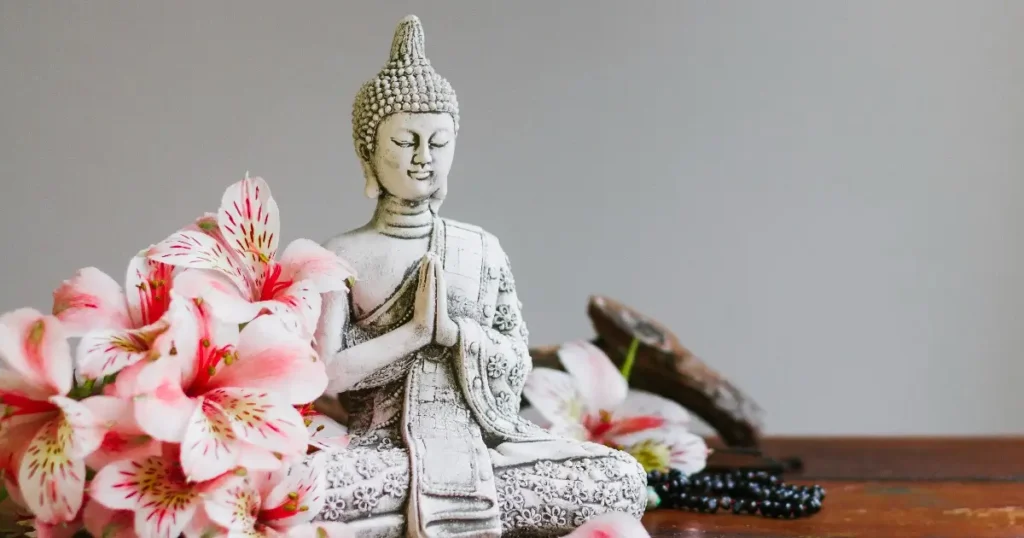What Is Candle Gazing (Trataka) Meditation?

Candle Gazing, or Trataka Meditation, emerges from the rich tapestry of ancient yogic practices, presenting a unique method where focus and intention meld to forge a significant meditative experience.
This article introduces Trataka Meditation, exploring the foundational elements that define this distinct technique. Rooted in tradition, Trataka stands out for its focused approach to meditation, primarily involving the steady observation of a candle flame.
We aim to provide you with a clear understanding of its practices and the role it plays within the wider context of meditation disciplines. Through this exploration, we illuminate the pathway that Trataka offers towards achieving mental clarity and inner calm.
Understanding Trataka Meditation

Trataka meditation, deeply entrenched in the yogic tradition, is a method designed to sharpen concentration, bolster mental clarity, and promote emotional stability through the practice of focused gazing.
This ancient technique requires practitioners to direct their gaze onto a single point of concentration, typically a candle flame, without blinking, until tears are produced.
The practice is divided into two stages: beginning with the external gaze (bahiranga trataka) on a physical object to stabilize the mind, and transitioning to internal gazing (antaranga trataka), where the practitioner visualizes the object with eyes closed, deepening the meditative state.
Trataka meditation is a yogic practice that enhances concentration and mental clarity through focused gazing, typically on a candle flame. This technique involves both external and internal gazing, aimed at stabilizing the mind and fostering a deeper meditative experience.
The primary goal of Trataka is to clear the mental clutter, allowing the practitioner to achieve a state of profound stillness and heightened awareness. By focusing intently on a single point, the distractions of the mind are gradually eliminated, paving the way for increased mental discipline and focus.
This practice not only strengthens the eye muscles and improves vision by stimulating the optic nerve but also significantly enhances cognitive functions, including memory and visualization skills.
Moreover, Trataka meditation has been found to have therapeutic effects on the mind and body. It induces a calming effect on the central nervous system, reducing symptoms of stress and anxiety, and promoting emotional equilibrium. The practice encourages mindfulness and presence, helping practitioners to develop a deeper connection with their inner selves, and fostering a sense of peace and well-being.
Incorporating Trataka into one’s daily routine can be a powerful tool for personal growth and self-discovery. It is a practice that requires minimal preparation and can be adapted to suit individuals at any level of their meditation journey. As such, Trataka stands as a testament to the profound benefits of yogic practices, offering a pathway to enhanced mental clarity, improved concentration, and a deeper understanding of the self.
Historical Background

The practice of Trataka, often translated as “to gaze steadily,” finds its roots deeply embedded in the rich soil of ancient yogic traditions. Documented references to this meditative technique can be traced back to several foundational texts of yoga and tantra, most notably the Hatha Yoga Pradipika. Written in the 15th century by sage Swatmarama, the Hatha Yoga Pradipika outlines Trataka as one of the six purification techniques (Shatkarmas) essential for the physical and mental preparation of practitioners on their path to higher states of meditation and consciousness.
The origins of Trataka extend beyond textual references, merging into the oral traditions that have shaped the practice of yoga throughout the centuries. This technique was traditionally taught from guru to disciple, with each generation refining and adapting the practice to suit the evolving needs of practitioners. Trataka’s emphasis on the purification of the mind and preparation for deeper meditative states underscores its value not only as a practice for enhancing physical vision but also for its potential to cultivate inner sight or insight, leading to spiritual awakening.
Over time, Trataka evolved, incorporating various objects of focus such as flames, symbols, and even natural elements, to accommodate the diverse spiritual and cultural contexts in which it was practiced. This evolution reflects the adaptable and inclusive nature of Trataka, allowing it to remain relevant and accessible to practitioners across different times and traditions.
In modern times, the practice of Trataka has been embraced by a wider audience, transcending its origins to become a global tool for stress reduction, concentration improvement, and spiritual exploration. Its integration into contemporary wellness and mindfulness practices highlights the enduring appeal and effectiveness of this ancient technique.
By examining the historical journey of Trataka, from ancient yogic texts to its present-day application, we gain not only a deeper understanding of its significance within the yogic tradition but also appreciate its potential to enhance our modern lives through improved mental clarity, focus, and inner peace. This enduring practice stands as a testament to the timeless wisdom of yoga, offering a bridge between the past and present in our collective quest for wellbeing and spiritual growth.
The Practice of Trataka Meditation

Trataka Meditation, an integral discipline within the broader scope of yogic practices, is revered for its simplicity and profound impact on the practitioner’s mental, physical, and spiritual well-being. This focused gazing technique, while straightforward in its application, encompasses a depth of practice leading to enhanced concentration, mental clarity, and inner peace.
Preparatory Steps
The effectiveness of Trataka is significantly influenced by the preparatory steps undertaken. Selecting a quiet, dimly lit space where distractions are minimized is crucial. The candle should be positioned at eye level, approximately an arm’s length away, ensuring the flame is stable and the seating is comfortable to facilitate ease throughout the practice. A few moments of mental preparation, setting intentions for the session, can also help in aligning the practice with personal goals or aspirations.
The External Gazing Phase (Bahiranga Trataka)
Initiating the practice with Bahiranga Trataka, practitioners focus their gaze on the candle flame, making an effort to blink as infrequently as possible. This phase is not about straining the eyes but rather about fostering a gentle, unwavering focus that cultivates concentration and trains the mind to release distracting thoughts. Upon the onset of discomfort or after a significant duration of steady gazing, the eyes are gently closed, marking the transition to the next phase.
The Internal Gazing Phase (Antaranga Trataka)
With the eyes closed, the practice transitions into Antaranga Trataka, where the practitioner visualizes the candle flame in the mind’s eye, ideally at the third eye’s location. This internal visualization deepens the meditative experience, enhancing mental clarity and stability. The goal is to maintain the image of the flame as vividly and as steadily as possible, reinforcing the mind’s focus and the ability to visualize.
Appropriate Setting and Environment for Practice
The setting plays a pivotal role in the efficacy of Trataka. A tranquil environment, free from external disturbances and with controlled lighting, supports the practice’s goals. Comfort in seating and body posture is also vital, as physical discomfort can distract from the meditative focus required in Trataka.
Duration and Frequency of Practice for Optimal Benefits
For newcomers to Trataka, starting with shorter durations of about 5 to 10 minutes is advisable, gradually extending the time as comfort with the practice grows. Regular, daily practice is recommended to cultivate and sustain the benefits of improved focus, mental clarity, and stress reduction. As proficiency increases, practitioners may extend the meditation period to 20-30 minutes, deepening the practice’s impact.
This structured approach to Trataka Meditation encapsulates a practice that, while ancient, remains profoundly relevant in contemporary wellness and spiritual disciplines. Its benefits, underscored by countless yogic texts and practitioners’ experiences, offer a testament to its enduring value in cultivating a focused, clear, and tranquil mind.
Trataka Meditation Variations

Trataka meditation encompasses several variations that cater to different preferences and objectives, allowing practitioners to explore and deepen their practice in diverse ways. These variations maintain the core principle of focused attention but diversify in terms of the objects of focus or the environment in which the practice is undertaken. Understanding these variations can help practitioners find the approach that resonates most with their personal meditation goals and circumstances.
| Variation | Description |
|---|---|
| Flame Trataka (Agnishikha Trataka) | The most traditional form involves gazing at the flame of a candle or lamp. This variation is widely practiced for its simplicity and the symbolic purity of fire, which aids in concentration and the burning away of impurities, both mental and physical. |
| Mirror Trataka (Darpana Trataka) | In this variation, the practitioner gazes at their own reflection in a mirror. This form of Trataka can be particularly powerful for self-inquiry and confronting internal challenges, fostering a deeper understanding of oneself. |
| Moon Trataka (Chandra Trataka) | Gazing at the moon, especially when it is full or in a crescent shape, offers a calming and cooling practice. This variation is beneficial for balancing emotions and calming the mind, contrasting the more intense focus associated with the flame. |
| Star Trataka | Similar to moon gazing, focusing on a star or a group of stars in the night sky can help cultivate a sense of connection with the vastness of the universe. This practice is often used for developing concentration and expanding one’s sense of self beyond the physical boundaries. |
| Black Dot Trataka | Placing a small black dot on a white background and focusing on it is another effective variation. This practice can be particularly useful for those who prefer a simpler visual focus point without the dynamic nature of a flame. |
| Natural Element Trataka | Focusing on natural elements such as a flowing stream, waves, or leaves rustling in the wind can offer a dynamic form of Trataka. This variation is beneficial for those who feel a deep connection to nature and seek to enhance their concentration while also cultivating a deeper appreciation for natural beauty. |
| Symbol Trataka | Gazing at a specific symbol, such as Om, a mandala, or a yantra, combines concentration with spiritual or symbolic contemplation. This variation can deepen one’s meditation practice by adding a layer of spiritual significance to the focus object. |
This structured approach to Trataka Meditation encapsulates a practice that, while ancient, remains profoundly relevant in contemporary wellness and spiritual disciplines. Its benefits, underscored by countless yogic texts and practitioners’ experiences, offer a testament to its enduring value in cultivating a focused, clear, and tranquil mind.
Integrating Trataka into Your Meditation Routine

Integrating Trataka into a broader meditation routine can significantly enhance the depth and effectiveness of one’s spiritual practice. Trataka, with its focus on steady gazing, offers a unique avenue for developing concentration and mental clarity, serving as a powerful adjunct to various meditation techniques. This chapter delves into the methods for combining Trataka with other meditation practices, facilitating a comprehensive approach to mental discipline and inner tranquility.
Enhancing Mindfulness Meditation with Trataka
Mindfulness meditation focuses on being present and fully experiencing the moment without judgment. By incorporating Trataka at the beginning of a mindfulness session, practitioners can achieve a heightened state of awareness and concentration, making it easier to observe thoughts, feelings, and sensations as they arise. The initial focus on a single point helps to stabilize the mind, setting a solid foundation for the subsequent practice of open awareness characteristic of mindfulness meditation.
Trataka and Mantra Meditation Synergy
Mantra meditation involves the repetitive chanting of a sacred word or phrase, promoting a deep state of relaxation and focus. Integrating Trataka by focusing on a visual representation of the mantra (such as a written symbol) can deepen the meditative experience. The visual focus complements the auditory repetition, engaging multiple senses and enhancing the practitioner’s ability to enter a meditative state. This combination can be particularly beneficial for those who find purely auditory or visual practices challenging to sustain.
Deepening Concentrative Meditation Practices
Concentrative meditation practices, such as focusing on the breath or a specific concept, benefit significantly from the preliminary practice of Trataka. The enhanced concentration and mental discipline developed through Trataka enable practitioners to maintain a singular focus with greater ease and for longer periods. This can lead to a more profound and undisturbed meditation experience, fostering deeper states of contemplation and insight.
Trataka and Loving-Kindness Meditation
Loving-kindness meditation (Metta Bhavana) aims to cultivate feelings of love, compassion, and goodwill towards oneself and others. Beginning a loving-kindness session with Trataka can help calm the mind and dissolve barriers to emotional openness. By first concentrating on a flame or another object of focus, practitioners can more readily generate and radiate feelings of warmth and compassion, enhancing the emotional depth and impact of the loving-kindness practice.
Integration with Movement-Based Practices
For practitioners of movement-based meditation practices such as Tai Chi, Qigong, or certain forms of yoga, incorporating Trataka can enhance mindfulness and presence during movement. Using Trataka as a preparatory practice helps cultivate an initial state of focus and mental clarity, which can then be carried into the movement practice. This integration encourages a deeper connection between mind and body, enriching the meditative aspect of physical movements.
Psychic Potential

Trataka meditation, while celebrated for its concentration-enhancing and mentally clarifying effects, also ventures into the realm of developing psychic potential, with the Ajna Chakra playing a pivotal role in this exploration. The Ajna Chakra, or the third eye, positioned at the center of the forehead between the eyebrows, is traditionally linked to intuition, insight, and a gateway to higher consciousness.
Through Trataka’s focused gazing practice, especially when directed towards a point that aligns with the Ajna Chakra, it is believed to activate and harmonize this energy center, potentially unlocking psychic abilities such as heightened intuition and extrasensory perception.
Scientific research into Trataka and its effects on the Ajna Chakra and psychic potential is sparse and often approaches the subject with skepticism. However, studies have documented Trataka’s benefits for cognitive functions, including improved concentration, reduced eye strain, and better mental health, providing a foundation for understanding its more subtle impacts.
While direct evidence linking Trataka to the activation of psychic abilities through the Ajna Chakra is limited, anecdotal reports and traditional accounts suggest a connection. Researchers in the fields of psychology and neurosciences are increasingly interested in exploring how meditation practices like Trataka influence brain function, particularly areas associated with awareness, attention, and perception.
Final Thoughts

Trataka meditation offers a compelling blend of cognitive enhancement and spiritual exploration, with potential insights into psychic abilities linked to the Ajna Chakra.
While empirical evidence on its effects on psychic development is limited, the practice is revered for its ability to improve concentration, mental clarity, and inner peace. Trataka stands as a valuable tool for those seeking to deepen their understanding of themselves and expand their consciousness. As research progresses, it may provide further insights into the practice’s traditional claims.
Regardless, Trataka remains a powerful practice for personal growth and mental discipline, inviting practitioners on a journey to explore the depths of their potential.

















